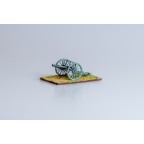This product is sold as an unpainted kit.
Additional Image.
1. Japanese Battery deployed for firing during the Russo-Japanese War.
THE JAPANESE 75 mm FIELD GUN
The Arisaka, Type 31, 75mm Field Gun was complete in service with the Imperial Japanese Army by 1902 and therefore was the principle Japanese field gun of the Russo-Japanese War. It had a Mountain gun variant which had a shorter range. The gun was designed by Arisaka Nariakira to replace the earlier bronze guns.
While considered by some to suffer from poor accuracy, the most remarkable characteristic was the extremely narrow and low structure. The gun used ammunition of cartridge shot type, it had a semi-rigid recoil system using cables connected to a set of springs and a screw breech with four segments. The effective range was 4,300m and the maximum range 7,700m. The gun was outperformed for range and rate of fire by the Russian field gun but the Japanese had the advantage of better crew training, fire discipline and co-ordination with the infantry arm. Where Russian artillery fired at a general area (the artillery is after all an area weapon) the Japanese gunners seem to have preferred to select specific targets when possible.
THE WARGAMER. I would suggest that, although there are technical and training differences between Russian and Japanese artillery, the fundamentals are very similar and therefore there is no need to differentiate between the sides on the wargame table. I always like to limit ammunition in my battles represented by the use of a small D6 next to the gun or limber. Re-supply being possible but at the loss of time and fire power. This mechanism I find prevents lots of long-range fire and forces the wargamer to think a little more carefully about how he might use his artillery resources.
Source: ‘Historical Dictionary of The Russo Japanese War’, Kowner, Rowman and Littlefield, 2017.





